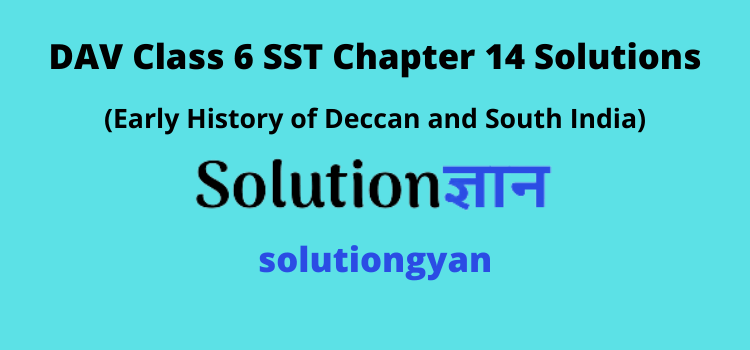DAV Class 6 SST Chapter 14 Question Answer Early History of Deccan and South India explores the exercises, given in the sst textbook We and Our World. These Class 6 SST Solutions of chapter 14 Early History of Deccan and South India exercises provided at the end of the chapter will be a useful resource for school exams.
Here at solutiongyan, we provide complete solutions of DAV class 6 History chapter 14 of We and Our World Book. These exercise of chapter 14 Early History of Deccan and South India contains 5 questions and the answers to them are provided in the DAV Class 6 SST Chapter 14 Question Answer.

Solutions of DAV Class 6 History chapter 14 Early History of Deccan and South India help to boost the writing skills of the students, along with their logical reasoning. Students can go through class 6 Social Science chapter 14 solutions to learn an effective way of expressing their answers in the exam.
DAV Class 6 History Chapter 14 Early History of Deccan and South India Solutions
DAV Class 6 SST Question Answer Chapter 14 Early History of Deccan and South India is given below. Here DAV Class 6 social science chapter 14 solutions is provided with great explanation.
Highlights
- Tick the correct option
- Fill in the blanks
- Match the following
- Answer the following questions in brief
- Answer the following questions
DAV Solutions of Class 6 Social Science of WE AND OUR WORLD Textbook is the best source for the students to self-analyse their performance. DAV Class 6 students are more likely to score good marks in the school exams if they practice DAV Class 6 SST Chapter 14 Early History of Deccan and South India Question Answer regularly.
DAV Class 6 SST Chapter 14 Question Answer
A. Tick the correct option.
1. What were the first indication of megalithic culture in South India?
Answer: burial sites
2. What culture did the megalithic culture give rise to?
Answer: Satavahana
3. The Pandyas set-up their capital at-
Answer: Madurai
4. The Satavahana dynasty came to an end in-
Answer: 220 CE
5. The Sangams during the Pandyas rule were held at –
Answer: Madurai
B. Fill in the blanks.
1. Deccan region is to the south of ___________ mountain and ___________ river.
2. King ___________ was the founder of Satavahanas empire.
3. The megalithic people surrounded the graves with large pieces of stone called ___________.
4. Canals for irrigation were built by ___________.
5. Nedunjeral and Senguttavan were the rulers of ___________dynasty.
Answer: (1) Vindhya, Narmada (2) Simuka (3) Megalith (4) kings (5) Chera.
C. Match the following:

Answer: (1) d (2) e (3) a (4) b (5) c.
D. Answer the following questions in brief.
1. Name the regions where Megalithic culture was concentrated.
Answer: Megalithic culture spread over the whole of India, its main concentration was in the Deccan, South India, the north-east and Kashmir.
2. Who was the most important king of the Pandya dynasty?
Answer: Nadunjeliam was the most important king of Pandya Dynasty.
3. Who took over the Satavahana empire in Maharashtra and Andhra region?
Answer: Satavahana empire was taken over by Rashtrakutas in Maharashtra and Ikshwakus in Andhra region.
4. The rock-cut chaitya hall at Karle is located at which present city of India?
Answer: The rock-cut chaitya hall at Karle is located in Pune (Maharashtra).
5. According to some archaeologists, what is the origin of the megalithic people?
Answer: Some archaeologists believed that Megalithic people of south India and Deccan were invaders from west Asia.
E. Answer the following questions.
1. Describe the main features of the Satavahana empire of Deccan.
Answer: The main features of Satavahana empire of Deccan are:
- Satavahana rulers believed in divine rights of the king.
- They were the followers of Hinduism. They worshipped Vishnu and Shiva.
- They divided kingdoms into provinces for efficient administration.
- Many chaityas, Stupas and Viharas were built during this period.
- They encouraged external and international trade and for which they built roads and ships.
- They had trade relations with Rome, Arabic, Iran, Egypt, Burma and Malaya.
2. Name three great empires of south India. What are the main sources of information about them?
Answer: Cholas, Pandyas and Cheras were the three great empires. Main sources of information are Sangam literature reference in Ashoka’s edict, Mahabharat, Jatak stories and travel accounts.
3. Highlight the main features of the pottery of the megalith period.
Answer: The main features of the pottery of the megalith period are:
- The pots were well-baked and well-fired.
- They were clearly made on the potter’s wheel.
- The remains of pottery found are mainly in black and red colours.
- Some pots still retain a shiny polish.
- The pottery pieces also have fine inscriptions which may be the trademarks of the potters.
4. What was the extent of the Chola empire? How did they settle themselves?
Answer: The Chola kingdom ruled over south India between Pennar and Velar rivers. The extent of their rule was always changing due to defeats or victories in wars with the neighbouring regions.
The Cholas set-up their capital at Kaveripattam but later they sifted it to Tanjore and Gangaikondacholapuram.
5. List the five geographical zones of southern kingdoms.
Answer: The five geographical zones of southern kingdoms are-
- Hills and Forests (kurinji)
- Pastureland (mullai)
- Fertile land
- Coastal land (neyte)
- Arid land

Thanks ????
Nice
Thank for the work
Very very thanks
This is very good website for doing homework like q/ans, back exercises etc and thanks for making this website and bye
This is very good. Thanks for helping in our homework….????????
This is very good website, thanks for helping
Nice. Our homeworks can be done easily. I love this ❤️❤️❤️❤️
I appreciate your work thanks ????
you must keep map work also
Try not to show advertisements please sir please
Please remove the advertisements sir plzz